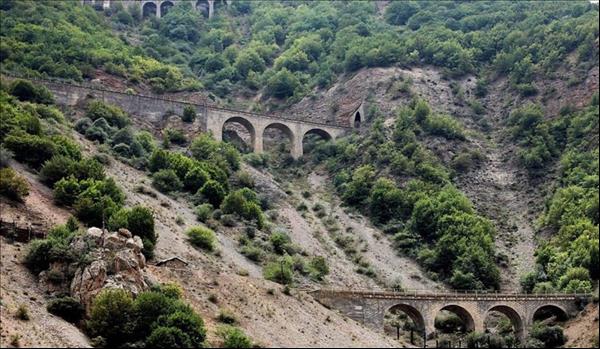(MENAFN- Asia Times) Russia and Iran hope that the International North-South Transport Corridor (INSTC) could be a game-changer for global trade. Even though the project is still far from being fully operational, officials from both countries have repeatedly framed the corridor as an alternative to the Suez Canal.
The INSTC consists of 7,200 kilometers of sea routes, rail links and roads that connect Mumbai to St Petersburg. The route runs from northern Russia across the Caspian Sea to southern Iran for shipment through the Strait of Hormuz and into the Arabian Sea, or Indian Ocean.
Moscow and Tehran hope the corridor will reduce reliance on the Suez Canal – one of the busiest shipping routes in the world, which currently accounts for about
12% of global trade
– and help Russia and Iran improve their positions in the international arena. A pair of deals this month have added momentum to the project, including an agreement on May 18 jointly to build and purchase 20 cargo ships .
According to Russian sources, it takes
30 to 45 days to deliver cargo
by sea from Mumbai to St Petersburg. But once a transit through Iran is established, it will take only 15 to 24 days.
Iranian President Ebrahim Raisi
said he believes
the INSTC“will help to significantly diversify global traffic flows,” and provide“obvious economic benefits” for both Iran and Russia. But the problem for Iranian and Russian strategic planners is that there is no guarantee the corridor will be completed any time soon – if at all.
The two countries have been discussing this project for more than 20 years. Railroad construction was stalled for years because of financial and logistical, as well as political, complications. It is rather questionable whether the Kremlin would have decided to invest in the corridor if the European Union and the United States had not imposed sanctions on Russia after its invasion of Ukraine.
Even some
iranian analysts
claim that before the war in Ukraine, Russian officials showed little interest in the construction of the INSTC railway, as they could ship goods from the Novorossiysk Port in the Black Sea to India.
Given that the war in Ukraine threatens Russia's Black Sea shipping operations, the Kremlin was forced to look for alternatives. Moscow, isolated from the West, now seeks to develop close economic, political and military ties with Tehran. The INSTC could be seen as the Kremlin's attempt to bypass Western sanctions and continue doing business with other countries more or less as usual.
But a sea route linking Russia and India via Iran does not resolve all of Moscow's problems. To make the corridor fully operational, the Kremlin will also have to complete the land route running from northern Russia through Azerbaijan into northern Iran and then to the Persian Gulf.
Russian funding
On May 17, Russian President Vladimir Putin signed a US$1.7 billion contract to build the
rasht-astara rail line , a project in northern Iran that will serve as a key cargo transit route within the INSTC system.
In other words, it is Moscow, rather than Tehran, that will fund the construction of a 162-kilometer railway between the Iranian cities of Rasht and Astara. It is
believed
that Russia will also build the railway linking Iran's Astara with the Azerbaijani city of the same name.
According to Putin, Russia, Iran and Azerbaijan are preparing an agreement on cooperation in the development of railway infrastructure and freight traffic along the north-south route.
Even though Russia has a
history
of constructing rail lines in the region – the first railways in Iran, connecting Tabriz and Mashhad, as well as Tehran and Isfahan, were built by the Russian Empire – under the current geopolitical circumstances, the fate of Putin's ambitious plan remains rather uncertain.
Even if Moscow and Tehran manage to complete the sea route of the INSTC,
tense relations
between Iran and Azerbaijan could have a significant impact on the land section.
Moreover, it will take at least
four years
for Russia to build railways in the region. Meanwhile, bogged down in Ukraine, the Kremlin could start facing large-scale turmoil at home, and such an outcome would undoubtedly affect its plans to complete the land corridor to Iran.
Given that the transportation network is expected to go through Azerbaijan – rather than via Russian ally Armenia's territory – Armenia is expected to continue
turning its back on moscow , which will be another consequence of Putin's decision to launch the ambitious but very risky geopolitical project.
More important, if the INSTC passes through Azerbaijan, Moscow and Tehran will become heavily dependent on Baku, a loyal ally of NATO member Turkey.
The fact that Iran indirectly
supports armenia against azerbaijan , and that tensions between Baku and Yerevan – be it over Nagorno-Karabakh or over other territorial and political disputes – remain high, additionally complicates the situation in the South Caucasus. Thus a wide range of geopolitical challenges lie ahead for Russia and Iran.
Finally, the corridor is heavily linked with the fate of the Russian and Iranian regimes. If either of the two countries face significant turmoil in the next few years, the realization of the INSTC will become quite uncertain.
This article was provided by
syndication bureau , which holds copyright.
Follow Nikola Mikovic on Twitter
@nikola_mikovic .
Like this:Like Loading...




















Comments
No comment